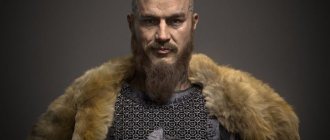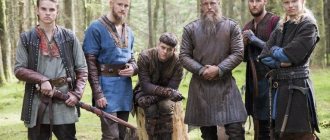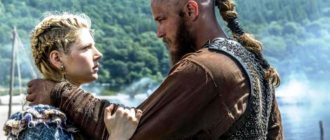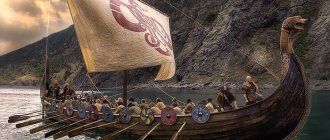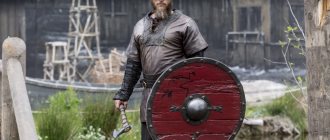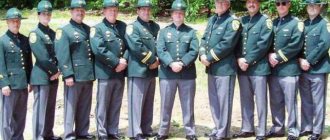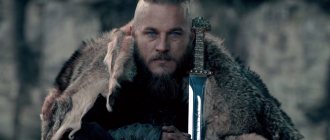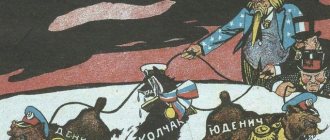Films and fiction have shaped the image of the Vikings, whom people imagine as savages in skins, leather armor, and helmets with horns on it. But all this is the imagination of directors and writers; in fact, the Vikings did not wear such headdresses, were free farmers, carried out conquests of neighboring territories, and built wooden longships.
The Vikings lived on the Scandinavian Peninsula, and already at the end of the 8th century. began to attack neighboring England and France. Residents of other parts of Europe, who first encountered the Danes and Norwegians, called them Normans, that is, northern people; ascemanns or ash people; madhus - pagan monsters. In Kievan Rus, the Vikings were called Varangians, in Ireland two names for the inhabitants of Scandinavia were common - Finngalls (light aliens) and Dubgalls (dark aliens), in Byzantium - Varangs.
Who are the Vikings?
The Anglo-Saxons believed that the Vikings came from Denmark, but it later became clear that this was not entirely true. In fact, they came from various regions of Scandinavia, including Denmark (as well as Norway, Sweden and others).
This sheds light on the origins of the Vikings. But the Vikings constantly sought beyond the Scandinavian region (you will find many examples in the article). They explored new horizons, traded and raided large parts of Europe. This historical period lasted from the 8th to the 11th centuries and was called the “Viking Age”.
At this time, the Vikings struck fear into their enemies, plundering and plundering coastal territories where peace and quiet had previously reigned.
Ivar Wide Arms
Legendary Scandinavian king of the 7th century. from the Skjoldung dynasty. Ivar managed to build a huge state. According to surviving documents, he conquered central Sweden, Denmark, Courland, Saxony, Estonia and all the eastern countries to Gardariki, as well as part of England Northumberland. The capital of his lands was the city of Rige on the island of Fyn (Denmark).
Ivar was an extremely cruel ruler. So much so that many people fled from his lands to other rulers. Ivar had an only daughter, Aud the Rich. Some sources claim that her direct descendant was Rurik.
But who are the Vikings?
The Vikings were the first and most prominent warriors of the Scandinavian region. They were often spoken of as villains or barbarians, and for good reason, as they attacked and ravaged peaceful coastal towns and monasteries throughout Europe. And yet, this is only one side of their life. Hollywood films form a clear, but very one-sided understanding of who the Vikings were. But many historical facts indicate that these people also wanted a calm, normal life.
Among the Vikings there were not only warriors, but also master craftsmen, farmers, traders, sailors and simply peaceful settlers. The term "Viking" itself means "pirate" or "robber". It can be assumed that this did not apply to all residents of the Scandinavian region. But to those they attacked, they were all Vikings - unfortunately, their victims only saw this side of their culture, and often it was the last thing they saw in life. But the Vikings could not survive solely on plunder in distant territories. Someone needed to establish settlements, cultivate the land and raise livestock.
There was also trade, including with distant countries. The Viking overland trade routes also passed through Russia and reached Constantinople in the territory of modern Turkey. The Vikings operated over very wide areas and even reached Baghdad in Iraq.
Sigurd Snake-Eyes
Danish king, another son of Ragnar, who later became his successor. After the death of his father, Sigurd received Zealand, Scania, Halland, the Danish islands and Viken. Legend has it that Sigurd was born with a mark in his eye described as Ouroboros (a serpent biting its own tail). Modern researchers believe that this mark could be the result of a congenital mutation of the Pax6 gene.
Vikings: the story of the beginning
As the Vikings traveled around the world, they encountered very different peoples, so they had to use different languages to communicate. At home, they spoke a language that today is called Old Norse.
Old Norse is a North Germanic language that was used in much of the Scandinavian region, including the Faroe Islands, Iceland and Greenland. Old Norse was also spoken in parts of Russia, France, the British Isles and Ireland. Considering the powerful influence the Vikings had in these territories at that time, this is quite natural.
Historians have found many ancient runes and inscriptions that provide information about how the Old Norse language was used. Runic writing is called Younger Futhark or Scandinavian runes. This is a runic alphabet that consisted of 16 characters and was mainly used during the Viking Age. As the influence and power of the Vikings began to weaken, it gradually fell out of use.
Bjorn Ironside
One of the sons of Ragnar Lothbrok, who later became King of Sweden. Unlike others, Bjorn is also famous for his raids not only in the northern seas. In 859, Bjorn reached Gibraltar and plundered the Mediterranean coast of Morocco. Then his path lay to the Balearic Islands and Provence. In 862, Bjorn returned to Britain, ruining Valencia on the way back.
What did the Vikings trade?
As already mentioned, the Vikings could travel long distances both by land and by sea, because in those days few, if any, could compare with them in the shipping business. This is one of the reasons why they were able to conquer so many peoples they met along the way. But what did they trade during their travels? What did you bring with you?
Viking traders often desired to purchase luxury goods such as silver, silk, spices, wine, jewelry, glass, and pottery. All this was in demand among the Vikings in their homeland.
As payment, they brought with them honey, tin products, wheat, wool, wood, iron, furs, leather, fish and walrus tusks. Unfortunately, the trading history of the Vikings also has a dark side, as they were actively involved in the slave trade.
Eric the Red and the discovery of Greenland
In 982, Erik the Red was expelled from the Icelandic colony for a murder he committed. He heard stories about lands lying about 1000 km from Iceland. He headed there with a small detachment. After a difficult voyage, he managed to find this land. In 986, Eric gathered a group of Vikings ready to settle on the island he had discovered.
Viking Campaigns
Of the 25 ships that sailed from Iceland, only 14 reached Greenland. More than 200 people died during the voyage. In the fjords of the western shore, Eric founded two settlements. The Normans were engaged in fishing and hunting seals, walruses, birds and arctic foxes. The colonists did not break ties with their homeland and sold furs and walrus tusks there, and in exchange received iron, timber, bread and fabrics. Two small groups lived on the island for 400 years.
Incredible mistakes
When the ships of Eric the Red moored to the shores of modern Greenland, an idyllic landscape spread out in front of the sailors - fields covered with dense vegetation. The conquerors immediately dubbed the new territory the Green Land - and, as it turned out, they were in a hurry. The Vikings stumbled upon a small oasis on the coast; if they had moved deeper into the island, they would have found themselves among the ice. A similar story, only exactly the opposite, happened with Iceland. Having landed on its shores, the Vikings saw mountains covered with snow and named the island Ice Land. But the first opinion again turned out to be wrong: Iceland is a green country where ice and snow are only occasionally found in the mountains.
Viking attacks in Europe
Although not all Vikings were merciless robbers and robbers, they really deserved such a reputation. They killed and plundered, and when they returned home, they proudly told their loved ones about their “exploits.”
The first documented attack on Anglo-Saxon territory occurred around 787. It began a confrontation that lasted for several centuries.
When the Vikings first appeared off the coast of Britain, the local population, in their simplicity of heart, prepared to welcome them with open arms. Unarmed people gathered on the shore to greet overseas guests. They paid dearly for this mistake - the Vikings swept along the coast like a plague, bringing death to the naive and defenseless inhabitants of these places.
Their ferocity and cruelty left the British in horror and confusion. The Vikings willingly plundered their shrines, such as Christian monasteries, where gold, silver, livestock and other riches were abundant.
For many, this was sacrilege, but the Vikings were eager for easy money and did not see a problem in this. They had no doubt whether it was worth attacking the holy monasteries, because they were pagans and the beliefs of the local population were alien to them. Time passed, and the conflicts between the Vikings and the Anglo-Saxons became increasingly large-scale and bloody.
Olaf Tryggvason
King of Norway from 995 to 1000. Olaf came to Rus' at the age of nine and lived here for another nine years. He was taken into the squad of Vladimir Svyatoslavich and fought in the campaign against the Cherven cities in 981. One interesting theory is connected with Olaf, which is partly confirmed by the Tale of Bygone Years, the Great Saga and some other historical documents. According to this theory, Olaf, while he was in Rus', once had a dream about heaven and hell, and had a vision that he should go to Greece and convert to Christianity. So he did. And upon returning from Greece, Olaf converted Vladimir Svyatoslavich and his wife to Christianity, thereby taking a direct part in the Baptism of Rus'.
Vikings: the story of the great invasion
As the population of Ireland and Britain increasingly resisted, and all the “easy” targets had already been plundered, the Vikings decided to unite and strike together in order to strengthen their power and take possession of the wealth hidden in the Anglo-Saxon lands. In 865, a huge army was formed, called, according to various sources, the Great Danish or Great Pagan Army. It included warriors from all over the Scandinavian region, but mainly from Denmark.
Previously, in their raids, the Vikings adhered to the tactics of fleeting combat with a quick retreat: to loot more before the enemy could fight back. The Vikings were satisfied with this state of affairs for the time being, but, as often happens, their appetites began to grow.
As can be learned from the legends, new goals required the creation of a more numerous and skilled army. One that would allow them to penetrate deep into the territories of the Anglo-Saxons and establish their own settlements there.
At the head of this army were three of the five sons of the legendary warrior Ragnar Lothbrok: Hvitserk, Ivar the Boneless and Ubba Ironside. Although historians do not have exact data on the size of this army, it is considered one of the largest of its time. The bloody war between the Vikings and the Anglo-Saxon kingdoms lasted for 14 long years.
Hoping to appease the invaders, Edmund the Martyr, King of East Anglia, offered them many horses as a gift. As one would expect, the Vikings did not accept the gift and marched with destruction through the lands of East Anglia. King Edmund himself was killed.
Conquest of England in the 10th century
At the beginning of the 10th century, the Danes again tried to capture England, which they succeeded only in 1016. The Anglo-Saxons managed to overthrow their power only forty years later, in 1050. But they did not have time to enjoy freedom. In 1066, a huge fleet under the command of William the Conqueror, a native of Normandy, attacked England. After the Battle of Hastings, the Normans reigned in England.
What happened to the Vikings?
For 14 years, the Vikings wreaked death and destruction across the Anglo-Saxon kingdoms. Through a series of advances and retreats, the Great Pagan Army overcame most of northern England within a few years and seized control of the Anglo-Saxon kingdoms of Northumbria, East Anglia and Mercia.
However, the Viking invasion stalled when a split appeared in their ranks and the army began to split into two parts.
This was the beginning of the end of the Viking campaign. They were defeated in an important battle against the forces of Wessex, the only kingdom that was able to withstand the onslaught of the invaders. The Wessex army, led by King Alfred, defeated half the Viking army at the Battle of Edington in 878, ending their hopes of complete control of the Anglo-Saxon kingdoms.
This victory gave Wessex enough time to begin to form a strong army and build defensive structures, which also prevented the invaders from advancing further.
Still, large parts of Britain remained under Viking rule. Essentially, the region was divided into two parts: the northern lands were still controlled by the Vikings, and the southern lands were controlled by the army of Wessex, led by King Alfred. The situation did not change until almost the end of the Viking Age.
First sack of London
Twenty years later, the Normans gathered a large army for a campaign against England and France. In 825 the Vikings landed in England, and in 836 London was sacked for the first time. In 845, the Danes captured Hamburg, and the city was so devastated that the episcopate located in Hamburg had to be moved to Bremen. In 851, 350 ships again appeared off the coast of England, this time London and Canterbury were captured (and of course plundered).
Decline of the Viking Age
At the beginning of the Viking Age, Europe was largely divided into isolated areas, where local militias found it extremely difficult to counteract Viking "shock and awe" warfare.
But time passed, the attacks continued, and the peoples of Europe began to unite, form a regular army and build defensive structures. This brought results, and in the absence of significant successes - and therefore profits - the Viking military strategy lost its meaning. Soon the era of their dominance in Europe ended. It can be said that their successes ultimately became the cause of their downfall.
Easy targets ceased to be such, and even in monasteries towers began to be built, where everything valuable could be quickly hidden and from which it was easy to defend.
Some cities moved further from the coast, making it more difficult for the Vikings to attack quickly and retreat quickly. In the end, as has often happened in history, money became the deciding factor: if something stops making a profit, then try something else. That's exactly what the Vikings did.
* * *
The arrow that struck the throat of Harald the Harsh brought an end to the Viking Age. Why? It's simple - Harald was the last Scandinavian ruler who used ancient methods. And William the Conqueror, who became the English king a month after the death of Harald, was a Norman in name only - and his campaign was not a “Viking”, but an ordinary feudal war. From now on, the Scandinavians were no different from other inhabitants of Europe. Their dashing raids remained in the tales of the skalds and on the brittle pages of monastic chronicles. And, of course, in human memory...
Source
Where are the Vikings now?
In the end, no one won a final victory over the Vikings. However, they began to be thwarted and resisted, so they had to reconsider both their military strategy and their way of life in general. Times have changed, and the Vikings have had to change too.
They were always interested in exploring new horizons, and in the process they were introduced to a huge number of new cultures. From them the Vikings began to borrow many customs and beliefs, which over time became part of their lives.
Pagan beliefs were supplanted by Christianity, which was actively spreading throughout the world at that time. By the end of the Viking Age it was firmly entrenched in their culture.
Most historians consider 1066 to be the end of this brutal era. The final point was the Battle of Stamford Bridge, where the troops of the Norwegian king Harald Hardrada, who sought to take control of a significant part of England, were defeated, and the king himself died. This was the last major Viking invasion of Europe. From then on, their reputation as pirates and robbers began to gradually be forgotten, which accelerated their integration into the cultural space of Europe.
Even the name “Vikings” fell into disuse. They were now called Danes, Swedes, Norwegians, Icelanders, Greenlanders and Faroese. The Viking Age is over, but centuries later they continue to live both in the legends left over from their times and in world art, becoming a vital part of the history of modern civilization.
The Viking theme remains one of the most popular in the gaming industry. On our website you can find free games in different genres, including games about Vikings. All you need to do is just go to the page of the game you like and download it to your PC or any other device.
In addition, our players can get unique nicknames for the game, which will undoubtedly help them win. Our unique nickname generator is developed using a special algorithm. You can generate a unique nickname in English according to your chosen gender.
Harald Bluetooth
The famous king of Denmark and Norway. According to a common version, he received his nickname because of the dark color of his teeth. But Harald is famous largely due to the fact that it was under him that in 965 Denmark officially adopted Christianity. This decision was mainly dictated by political benefits - improved relations with the neighboring Holy Roman Empire and the enlightened Christian world in general.
According to one of the common versions, Harald was killed during the war with his son Sven Forkbeard. The reasons for their disagreements are said to be Harald's commitment to the church and the desire to strengthen its powers in the state, while Sven was a pagan and was very fond of traditional raids. Harald Bluetooth is canonized by the Catholic Church.
Definitions from encyclopedias
VIKINGS (Old Scandinavians), Scandinavians - participants in maritime trade, predatory and conquest campaigns at the end of the 8th - mid-11th centuries. to European countries. In Rus' they were called Varangians, and in Western Europe - Normans (Scand. Northman - “northern man”). In the 9th century captured Northeast England in the 10th century. - Northern France (Normandy). Reached North America.
Cloth.
Peasant clothing consisted of a long woolen shirt, short baggy pants, stockings and a rectangular cape. Vikings from the upper classes wore long pants, socks and capes in bright colors. Woolen mittens and hats, as well as fur hats and even felt hats, were in use. Women from high society usually wore long clothes consisting of a bodice and a skirt. Thin chains hung from the buckles on the clothes, to which scissors and a case for needles, a knife, keys and other small items were attached. Married women wore their hair in a bun and wore conical white linen caps. Unmarried girls had their hair tied up with a ribbon.
Weapon.
The weapons of the Vikings were bows and arrows, as well as a variety of swords, spears and battle axes. Swords and spear and arrowheads were usually made of iron or steel. Yew or elm wood was preferred for bows, and braided hair was usually used as a bowstring.
Viking shields had a round or oval shape. Usually the shields were made from light pieces of linden wood, trimmed along the edges and across with iron strips. There was a pointed plaque in the center of the shield. For protection, warriors also wore metal or leather helmets, often with horns, and warriors from the nobility often wore chain mail.


